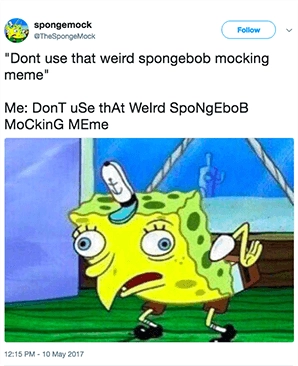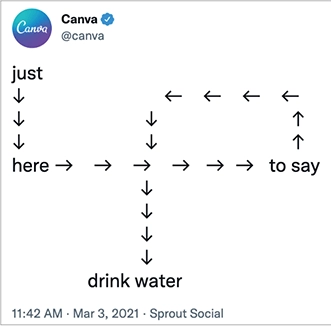Social Media Accessibility
There are many users on social media that have disabilities. Some of these users may be using assistive technology. We've come up with some things that everyone can do to make their social media accounts more accessible to these users, and to everyone else!
General Formatting Principles
- Format content left to right.
- Use punctuation appropriately.
- Don’t use custom fonts.
- Some screen readers skip them altogether or have a hard time reading them, and it affects the searchability of your account.
- Don’t use “Spongebob case”.
- Spongebob case became a popular way of using letters and numbers to write a sentence in a “mocking” way associated with a popular Spongebob meme. However, a screen reader will only read the text as letters and numbers instead of words, making your content inaccessible. The following image is an example of Spongebob case from the Spongemock X (Twitter) account:

- Spongebob case became a popular way of using letters and numbers to write a sentence in a “mocking” way associated with a popular Spongebob meme. However, a screen reader will only read the text as letters and numbers instead of words, making your content inaccessible. The following image is an example of Spongebob case from the Spongemock X (Twitter) account:
Hashtags
Hashtags should be written in CamelCase, which is the first letter of each word capitalized. This helps screen readers understand and read the words of the hashtag separately instead of combining them into one word. It also helps everyday users decipher words in your hashtags.
- Instead of #utahstateaggies use #UtahStateAggies
Emojis
Emojis are a fun way to express emotion or change things up from plain text. However, overuse of emojis can be difficult for social media users that use a screen reader. Keep in mind that a screen reader only reads the description designated for an emoji. Some examples are “grinning face”, “face with tears of joy”, and “smiling face with heart-eyes”. Follow these guidelines to make the most of your emoji use while still keeping your content accessible:
Don’t Use Emojis to Replace Words or Numbers
You never know how these will actually be read by a screen reader or if it will be understood by a user in the way you were meaning.
Don’t Replace Words or Emotions With Emojis
Instead of using an emoji in place of emotions or words, put them at the end of the message or beside the word they are representing. This also helps ensure your emoji is interpreted correctly.
Example: “I like my sunglasses😎!” instead of “I like my 😎"
Don’t Repeat or Overuse Emojis
Emojis are fun in moderation, but used in excess can cause screen reader users to get lost in your message. Listening to 10 “kissing face with closed eyes” in a row can be time-consuming for those trying to get to the point of your message.
Put Any Important Information Before Emojis
If there is something important you are trying to communicate to those viewing your social media content, make sure to put it before using any emojis.
Don't Use Emojis as Bullet Points
Using emojis as bullet points is confusing for a screen reader user because the emoji description interrupts the main body of the points. As stated above, put important information in front of emojis.
Use Emojis That Are Well Known
Using popular emojis helps those who may have a disability. It also helps ensure that the meaning of your emoji is understood by individuals from various cultures.
ASCII-Art
ASCII-Art is created by using symbols or text characters built into the ASCII system. An example of ASCII-art used on the Accessible Social website from the company Canva on X (Twitter) is shown above. Screen-readers read ASCII-Art and emoticons by symbol, from left to right, which won’t make sense. If you choose to use ASCII-art, be sure to include a description of it nearby. The most accessible way to include ASCII-art, however, is to use a screenshot with descriptive alt text.
Alt Text for Photos
See our alt text guidelines.
There are a few things specific to social media that we don't want to use when writing alt text:
- Emojis
- Links
- Hashtags
- Additional symbols
Adding Alt Text (For Mobile Devices):
Facebook:
- Begin creating a post.
- Add a photo to the post.
- Select the three horizontal dots in the right-hand corner by the “X”.
- Select edit alt text.
- Add your alt text.
- Post!
Instagram:
- Begin creating your post.
- Add your photo(s).
- Once you are on the page to write a caption, click Advanced Settings.
- Scroll down to Accessibility and select Write Alt Text.
- Add your alt text and select Done.
- Post!
X (Formerly Known as Twitter):
- Begin creating a post.
- Add a photo to your post.
- In your photo, select the button that says +ALT.
- Write your alt text and select Done.
- Post!
Additional Resources
- Accessibility Tips for Social Media: How to Create Content That Everyone Will “Like”
- Accessible Social: Creating Accessible and Inclusive Social Media Content
- Princeton’s Social Media Accessibility Guidelines
- University of Rochester Social Media Accessibility Guidelines
- 8 Guidelines to Make Social Media Posts More Accessible
- A Guide to Basic Accessibility on Social Media: Easy, Actionable Ways to Make Your Content More Inclusive
- West Virginia University’s Social Media Accessibility
- American Foundation for the Blind's Social Media Accessibility Guidelines
- Emojis | Readability Guidelines


